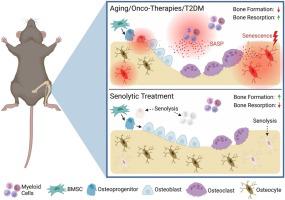Mechanisms of Ageing and Development ( IF 5.3 ) Pub Date : 2021-09-06 , DOI: 10.1016/j.mad.2021.111565 Madison L Doolittle 1 , David G Monroe 1 , Joshua N Farr 1 , Sundeep Khosla 1

|
The skeletal system undergoes irreversible structural deterioration with aging, leading to increased fracture risk and detrimental changes in mobility, posture, and gait. This state of low bone mass and microarchitectural changes, diagnosed as osteoporosis, affects millions of individuals worldwide and has high clinical and economic burdens. Recently, pre-clinical studies have linked the onset of age-related bone loss with an accumulation of senescent cells in the bone microenvironment. These senescent cells appear to be causal to age-related bone loss, as targeted clearance of these cells leads to improved bone mass and microarchitecture in old mice. Additionally, other pathologies leading to bone loss that result from DNA damage, such as cancer treatments, have shown improvements after clearance of senescent cells. The development of new therapies that clear senescent cells, termed “senolytics”, is currently underway and may allow for the modulation of bone loss that results from states of high senescent cell burden, such as aging.
中文翻译:

senolytics 在骨质疏松症和其他骨骼疾病中的作用
随着年龄的增长,骨骼系统会发生不可逆转的结构退化,导致骨折风险增加以及活动性、姿势和步态的有害变化。这种低骨量和微结构变化的状态被诊断为骨质疏松症,影响着全世界数百万人,并带来高昂的临床和经济负担。最近,临床前研究已将与年龄相关的骨质流失的发生与骨骼微环境中衰老细胞的积累联系起来。这些衰老细胞似乎是与年龄相关的骨质流失的原因,因为这些细胞的靶向清除会导致老年小鼠的骨量和微结构得到改善。此外,由 DNA 损伤导致的其他导致骨质流失的病症,例如癌症治疗,在清除衰老细胞后显示出改善。











































 京公网安备 11010802027423号
京公网安备 11010802027423号